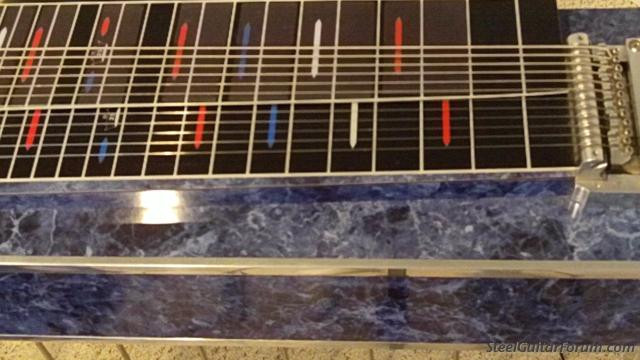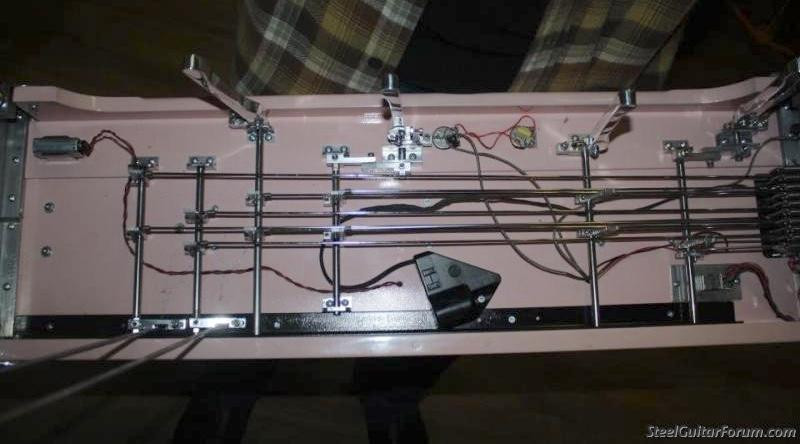Page 1 of 2
Russ Pahl - why Eb?
Posted: 18 Mar 2019 7:02 am
by K Maul
He has a very simple but interesting set up with two pedals and four knee levers. I’m wondering why he tunes to Eb9 instead of E9. Why not D9? I am speculating that it is because a lot of the modern “country†groups are tuning down a half step. Maybe it is because of their Heavy metal roots. Haha. I guess it does have some advantages sonically. Can anyone clarify?
Posted: 18 Mar 2019 7:18 am
by Dom Franco
When you play in the key of A or E it makes it possible to have a "Barred" low position rather than open strings that can sound different (more jangly) than a fretted chord. It also allows blocking (damping) behind the bar, which is impossible with open strings...
Posted: 18 Mar 2019 8:24 am
by ajm
My first guess was that breaking strings should be much less of an issue, providing you use the same gauges.
But until Russ answers we don't know why he personally does it.
Posted: 18 Mar 2019 10:27 am
by Ian Rae
I reckon it could be either to get open-string voicing in the key of Eb, or to avoid open strings in the key of E. Looking forward to finding out.
(I don't know that the Bb universal was designed to play in flat keys necessarily.)
Posted: 18 Mar 2019 11:03 am
by Johnny Cox
Eb because his guitar is a 25" scale.
Posted: 18 Mar 2019 2:09 pm
by Ian Rae
Plenty of guitars are 25.5" scale. So what?
Posted: 18 Mar 2019 3:23 pm
by Johnny Cox
his isn't keyless.
Posted: 18 Mar 2019 3:36 pm
by Ian Rae
A lot of people are convinced that makes a difference, but physics says no. The tension to obtain the same pitch from the same gauge string at the same vibrating length is the same, whatever the distance between the nut and the anchor point.
Posted: 18 Mar 2019 5:12 pm
by Harry Dove
Here is the formula for determining string tension. The formula indicates that scale length is one of the variables in determining string tension.
To calculate the Tension of a string in pounds, use this equation:
T = [UW x (2 x L x F)2] ÷ 386.4
T = Tension. String tension is measured in pounds of pull per string.
UW = Unit Weight. Unit weight is expressed in pounds per linear inch (lb/in).
L = Scale Length. This is the vibrating length of the string. (To determine a guitar’s specific Scale Length, first measure then double, the distance from the nut to the center of the 12th fret.)
F = Frequency or pitch. This is the pitch at which you will be tuning the string, expressed in cycles per second (Hertz).
Posted: 18 Mar 2019 5:17 pm
by Russ Pahl
I was curious that some of my favorite guitarists tuned down a half step....
Robert Johnson
Jimi Hendrix
Stevie Ray Vaughn
Eddie Van Halen
Don Rich & Buck Owens
There are various reasons for this...
Vocal range
Easier string bending
And lastly, I sensed that some of these guys were doing it because it changes the “behavior†of the guitar.....that intrigued me.
I tuned down, put on heavier strings (15-46) and lengthened my guitar to 25 inches.
I liked the result!
The guitar has a “meatier†feel....more resistance, more string tension (though it doesn’t break strings)
I’ve been in E flat for many years.
There’s an interesting side effect.....
Growing up playing in club bands, there were favored keys
E, G, A,C, D, etc.....that meant that some keys were neglected, hence they became my “bad†keys.
Now the entire fretboard is a level playing field and every key is a “bad†key.....over time I’ve learned them all equally....I’m no longer afraid of C# or A flat, or even my new friend E flat!
I hope this helps,
Russ
Posted: 18 Mar 2019 7:21 pm
by K Maul
Thank you Russ! That is just the answer that I wanted to get. I knew about Hendrix and all the other ones too. Currently a band I’m playing with in Florida tunes to Eb. But we pretend it’s E.... Ha ha.
I think it’s a good idea and I really appreciate your innovations in many areas. I love the onboard controls on the Show Pro. I have done that myself, inspired by Sneaky Pete.
Not that I want to bug you with too many questions but I’d like to know how you control things from your steel. I am assuming you have a rack delay so you can just dial in the exact tempo numbers but you seem to control it from the steel. I’d love to see a picture of the undercarriage of that thing.
Your answer helps quite a bit.
Posted: 19 Mar 2019 9:01 am
by David Spires
Isn't it fantastic to have this forum, where a player like Russ takes their time to share what they have learned?!
Thank you, Russ Pahl!! You're a creative monster. Love your work.
Sincerely,
David Spires
Posted: 19 Mar 2019 10:04 am
by Pete Burak
I tuned to Eb when I played with a band that did alot of songs in E and A.
I loved being able to play E and A (and all them other chords) at the first fret!
The side effect I noticed is that, I was never playing on a harmonic node anymore.
Like when you play an E or A at the 12th fret and you have to mute the strings behind the bar, that went away.
I made a special fretboard that moved all the fret markers up one fret, also.
The pedals and levers all worked better too.
I am back in E at the moment but I wish I had started from day one in Eb.
Posted: 20 Mar 2019 9:07 am
by John McClung
Steely Pete, that idea behind your custom fretboard is pretty brilliant! So the fret markers are at 4, 6, 8, 10, etc.?
Posted: 20 Mar 2019 3:14 pm
by Pete Burak
Here it is.
I just slide the Eb-fretboatd over the E-fretboard, for now.
The fret-markers are still where I am used to seeing them on my gigs, so I don't have to play one fret off.
I tune to Eb and fret-1 is open-E.

Posted: 21 Mar 2019 2:16 am
by Jack Stoner
Who am I to question a Pro on their tuning, but I've never had any issues with tuning to E. But then I'm one of the few left that still uses high G on the C6th tuning.
Posted: 21 Mar 2019 5:04 am
by K Maul
I use hi G,too. I mostly play real old school swing and honky tonk C6 and don’t use pedals too much on my ‘59 Permanent with its limited changer capabilities. The 5 on top is more useful to me than the D.
Posted: 21 Mar 2019 7:38 am
by Floyd Lowery
Jack Stoner wrote:Who am I to question a Pro on their tuning, but I've never had any issues with tuning to E. But then I'm one of the few left that still uses high G on the C6th tuning.
The petal steel is an instrument that can be tuned so many different ways and then set up with petals and knee levers doing different movements. It is not something for just any player to sit in and play another mans instrument. The comfort for one is foreign to another. Main thing is to have what you want on your guitar. Only another petal steel player may know what kind of tuning you are using. 99.9% of the rest of the band might guess, but they do not know. For example I've had a guitar played tell me I would do better to tune to E9 instead of B6. 90% of what I was playing was E9. but I told him when I went to work with him I had B6 when I dropped my Es.
Posted: 21 Mar 2019 3:03 pm
by John McClung
Pete, I want to visit you and try that out!
Posted: 21 Mar 2019 3:58 pm
by Craig Stock
Thanks Russ for your input, am loving your work on Kacy Musgraves recordings, I always know when you are in the room! Your style is very noticeable which is a great thing, only need to hear a few notes.
Posted: 23 Mar 2019 8:34 am
by K Maul
After doing some poking around and fishing, I found a picture of Russ’s undercarriage...doesn’t tell me too much about how he controls the delay. I think I see some kind of multi conductor cable over there on the right side which must go to the digital rack mounted delay units.

Posted: 23 Mar 2019 10:22 am
by Tony Glassman
Pete Burak: The slip-on modded fretboard us a very elegant solutioon. I probably would have spent 3 months re-learning the fretboard before ultimately throwing in the towel.
Posted: 23 Mar 2019 11:54 am
by Marc Muller
Russ Pahl wrote:I was curious that some of my favorite guitarists tuned down a half step....
Robert Johnson
Jimi Hendrix
Stevie Ray Vaughn
Eddie Van Halen
Don Rich & Buck Owens
There are various reasons for this...
Vocal range
Easier string bending
And lastly, I sensed that some of these guys were doing it because it changes the “behavior†of the guitar.....that intrigued me.
I tuned down, put on heavier strings (15-46) and lengthened my guitar to 25 inches.
I liked the result!
The guitar has a “meatier†feel....more resistance, more string tension (though it doesn’t break strings)
I’ve been in E flat for many years.
There’s an interesting side effect.....
Growing up playing in club bands, there were favored keys
E, G, A,C, D, etc.....that meant that some keys were neglected, hence they became my “bad†keys.
Now the entire fretboard is a level playing field and every key is a “bad†key.....over time I’ve learned them all equally....I’m no longer afraid of C# or A flat, or even my new friend E flat!
I hope this helps,
Russ
I'm not afraid of C# or A flat but terrified of D flat and G sharp!
BTW, I was Van Zant steeler on the road and really dug learning your parts. Made me sound like I was good. ha
Posted: 23 Mar 2019 7:02 pm
by David Mason
I guess in the interest of World Peace, or maybe just Forum Peace, NO-body's mentionS my most important reason:
TONE!
AAAH! Crap! Hide! ripe tomatoes only, plz! I'm militantly sixy only (6th-ey?) but every pedal steel I ever met SOUNDS BETTER to me with slightly softened strings. That would be tuned to Bb but with strings from a C6th set. It sounds stringier, nuancy-er, more human, less chrome-plated Nazi Robotone... I'm hung in A6th these days, but with strings most would use for G.
E 15
C# 17
A 19
F# 24
E 28
C# 34
A 42
F# 46
D 56
A 66
Posted: 24 Mar 2019 6:50 am
by Richard Sinkler
Russ, if you are still reading this post, could you comment on your built-in effects. I watched the movie, "Dear Jerry" again last night. Awesome stuff you did on that show.

